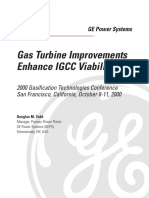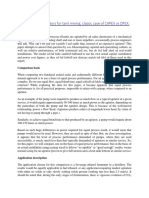Vapor Cycle District Heating Plants
Vapor Cycle District Heating Plants
Uploaded by
ali jabarCopyright:
Available Formats
Vapor Cycle District Heating Plants
Vapor Cycle District Heating Plants
Uploaded by
ali jabarOriginal Title
Copyright
Available Formats
Share this document
Did you find this document useful?
Is this content inappropriate?
Copyright:
Available Formats
Vapor Cycle District Heating Plants
Vapor Cycle District Heating Plants
Uploaded by
ali jabarCopyright:
Available Formats
478 Chapter 8 Vapor Power Systems
+
–
Turbine
1
Fuel
Boiler
2
Steam
Condensate
Pump
4 3
(a) Back-pressure plant.
+
–
1
Fuel 2
(1)
3
Cooling tower
(y)
To cooling tower
Condensate
(1)
(1 – y)
5
6 (1 – y) 4
Steam
(y)
Condensate
(b) Extraction plant.
Fig. 8.14 Vapor cycle district heating plants.
CO2 in the atmosphere contributes to global climate change, and there is growing
agreement that measures must be taken to reduce such emissions.
Carbon dioxide emissions can be reduced by using fossil fuels more efficiently and
avoiding wasteful practices. Moreover, if utilities use fewer fossil-fueled plants and more
wind, hydropower, and solar plants, less carbon dioxide will come from this sector.
Practicing greater efficiency, eliminating wasteful practices, and using more renewable
energy are important pathways for controlling CO2. Yet these strategies are insufficient.
Since they will be plentiful for several decades, fossil fuels will continue to be used
for generating electricity and meeting industrial needs. Accordingly, reducing CO2
emissions at the plant level is imperative. One option is greater use of low-carbon
fuels—more natural gas and less coal, for example. Another option involves removal
of carbon dioxide from the exhaust gas of power plants, oil and gas refineries, and
other industrial sources followed by storage (sequestration) of captured CO2.
Figure 8.15 illustrates a type of carbon dioxide storage method actively under
consideration today. Captured CO2 is injected into depleted oil and gas reservoirs,
unminable coal seams, deep salty aquifers, and other geological structures. Storage in
oceans by injecting CO2 to great depths from offshore pumping stations is another
method under consideration.
You might also like
- 9e Gas Turbine PDFDocument98 pages9e Gas Turbine PDFAhmed Albasrawee100% (4)
- Design Philosophy of A Mixed Feed Cracker Dharmendra Narang Chief Engineer Technipfmc 6825 PDFDocument25 pagesDesign Philosophy of A Mixed Feed Cracker Dharmendra Narang Chief Engineer Technipfmc 6825 PDFNAVEEN AVVARUNo ratings yet
- Duel Feed Cracker Unit Associated UnitDocument37 pagesDuel Feed Cracker Unit Associated UnitRamesh mudunuri55% (11)
- The Engineer's Guide To Plant Layout and Piping Design For The Oil and Gas Industries, Geoff Barker, 2018 PDFDocument28 pagesThe Engineer's Guide To Plant Layout and Piping Design For The Oil and Gas Industries, Geoff Barker, 2018 PDFLawrensiaNo ratings yet
- Gti'S Acid Gas Treating Pilot Plant (Agtpp) Relocation and Integration With Flexfuel FacilityDocument23 pagesGti'S Acid Gas Treating Pilot Plant (Agtpp) Relocation and Integration With Flexfuel FacilityNattapong PongbootNo ratings yet
- Comb CycleDocument9 pagesComb Cyclecadi9No ratings yet
- Combined Gas CycleDocument4 pagesCombined Gas Cyclesohaib389892No ratings yet
- GT Frame 9 ManualDocument98 pagesGT Frame 9 ManualVenkat Madhav Moduga100% (1)
- Reliance GT-FRAME-9-MANUALDocument97 pagesReliance GT-FRAME-9-MANUALkishoremarNo ratings yet
- Thermodynamic and Economic Analysis of A Binary Geothermal Power Plant Feasibility Study4Document24 pagesThermodynamic and Economic Analysis of A Binary Geothermal Power Plant Feasibility Study4Angela Paul PeterNo ratings yet
- Gas Turbine Improvements Enhance IGCC ViabilityDocument16 pagesGas Turbine Improvements Enhance IGCC Viabilityherysyam1980No ratings yet
- Catalytic Answer To A Steam Cracking Challenge-EnglishDocument5 pagesCatalytic Answer To A Steam Cracking Challenge-EnglishRavishankar SNo ratings yet
- Gas Reinjection: Workshop on"CDM Methodology Issues Related To Gas Flaring"Document29 pagesGas Reinjection: Workshop on"CDM Methodology Issues Related To Gas Flaring"Waleed El-azabNo ratings yet
- 1 MW Pilot Testing and Scale-Up of The Carbonate Looping Process in The SCARLET ProjectDocument3 pages1 MW Pilot Testing and Scale-Up of The Carbonate Looping Process in The SCARLET ProjectMuhammad Adnan LaghariNo ratings yet
- 180.070 SG3 GlobalExcelDocument16 pages180.070 SG3 GlobalExcelMechanical PowerNo ratings yet
- FCC - Craqueo Catalítico LINDEDocument2 pagesFCC - Craqueo Catalítico LINDEJosé Luis FerreiroNo ratings yet
- 16 Nayeem AYON Final Design Slide 1Document34 pages16 Nayeem AYON Final Design Slide 1Sumit Ghosh KabboNo ratings yet
- Organic Rankine Cycles Organic Rankine Cycles: Bottoming Cycle Superheater Vapor A e 1Document1 pageOrganic Rankine Cycles Organic Rankine Cycles: Bottoming Cycle Superheater Vapor A e 1ali jabarNo ratings yet
- Waste Heat Recovery Potential From Industrial Bake - 230720 - 102949Document8 pagesWaste Heat Recovery Potential From Industrial Bake - 230720 - 102949Nurain AliNo ratings yet
- Design For Blast Furnace Gas Firing Gas Turbine: (Hereinafter Abbreviated As BFG)Document12 pagesDesign For Blast Furnace Gas Firing Gas Turbine: (Hereinafter Abbreviated As BFG)jnmanivannanmech100% (1)
- Lozza - Full Paper PDFDocument8 pagesLozza - Full Paper PDFMakhdum Muhardiana PutraNo ratings yet
- Repowering Diesel Engine Powered Thermal Power Plants Through A Power and Cooling Cogeneration CycleDocument6 pagesRepowering Diesel Engine Powered Thermal Power Plants Through A Power and Cooling Cogeneration Cyclesheiladunton13No ratings yet
- Zero Residue RefineryDocument9 pagesZero Residue Refineryapi-3709413No ratings yet
- WHRB Cement 2021Document5 pagesWHRB Cement 2021Anupam KushalNo ratings yet
- Advanced Natural Gas Reciprocating Engines (ARES) : DE-FC26-01CH11079 Caterpillar, Inc. May 2001 - June 2011Document26 pagesAdvanced Natural Gas Reciprocating Engines (ARES) : DE-FC26-01CH11079 Caterpillar, Inc. May 2001 - June 2011guichen wangNo ratings yet
- Co2 2021Document28 pagesCo2 2021Mandeep SinghNo ratings yet
- Ger 3428a Fuels Flexibility HDGTDocument33 pagesGer 3428a Fuels Flexibility HDGTJosemar LopesNo ratings yet
- Turboexpanders: CompressorsDocument4 pagesTurboexpanders: Compressorsdhanu_aquaNo ratings yet
- Integrated Gasification Combined CycleDocument10 pagesIntegrated Gasification Combined CyclemicmechNo ratings yet
- GT2002 30014Document7 pagesGT2002 30014ME THE BESTNo ratings yet
- Exposé Siwar & Chiriie Modifié 19-06 - 2023Document40 pagesExposé Siwar & Chiriie Modifié 19-06 - 2023ranimbj2001No ratings yet
- JM LCH Nott SAFDocument32 pagesJM LCH Nott SAFlhphong021191No ratings yet
- Revamping A Crude Distillation UnitDocument4 pagesRevamping A Crude Distillation Unitdharmendra singh bhatiNo ratings yet
- Prereforming: Based On High Activity Catalyst To Meet Market DemandsDocument8 pagesPrereforming: Based On High Activity Catalyst To Meet Market Demandsvaratharajan g rNo ratings yet
- Cemcap: Grant Agreement NumberDocument35 pagesCemcap: Grant Agreement NumberSiraj AL sharifNo ratings yet
- Advantages of Alkaline Fuel Cell Systems For MobilDocument7 pagesAdvantages of Alkaline Fuel Cell Systems For MobilViet NguyenNo ratings yet
- Minimize Evaporation Losses by Calculating Boiloff Gas in LPG Storage TanksDocument6 pagesMinimize Evaporation Losses by Calculating Boiloff Gas in LPG Storage Tanksaegean227No ratings yet
- 4 004 Potassium Carbonate Carryover PDFDocument25 pages4 004 Potassium Carbonate Carryover PDFZen AlkaffNo ratings yet
- MAN - ME-GI Dual Fuel A Technical, Operational and Cost-Effective Solution For Ships Fuelled by GasDocument32 pagesMAN - ME-GI Dual Fuel A Technical, Operational and Cost-Effective Solution For Ships Fuelled by GasjhonNo ratings yet
- Application of A Chilled Ammonia-Based Process For CO Capture To Cement PlantsDocument9 pagesApplication of A Chilled Ammonia-Based Process For CO Capture To Cement PlantsAkash NamdeoNo ratings yet
- TurbosCO2 Waste Heat PDFDocument21 pagesTurbosCO2 Waste Heat PDFAndrés OrtizNo ratings yet
- Corzan LNG Power PlantDocument6 pagesCorzan LNG Power PlantTCG chanelNo ratings yet
- Improving The Performance of FCC Units by Oxygen Enrichment. Update April 2017 To Strategic Links Design - tcm17-423478Document2 pagesImproving The Performance of FCC Units by Oxygen Enrichment. Update April 2017 To Strategic Links Design - tcm17-423478Abdul KudusNo ratings yet
- GSFC Thermal FinalDocument46 pagesGSFC Thermal FinalKuldeep RupareliaNo ratings yet
- 15.00 - Tahir AbbasDocument16 pages15.00 - Tahir AbbasΒΑΣΙΛΗΣ ΜΑΥΡΙΔΗΣNo ratings yet
- Lab Sheet Djj20063 - AllDocument21 pagesLab Sheet Djj20063 - Allzahrulirfan30No ratings yet
- Major Risks in Ammonia PlantsDocument17 pagesMajor Risks in Ammonia PlantsrobertionNo ratings yet
- Severe Surge Incidents at Process Air Compressor, Their After Effects and Problem ResolutionDocument15 pagesSevere Surge Incidents at Process Air Compressor, Their After Effects and Problem ResolutionAbhimanyu SharmaNo ratings yet
- Wa0048.Document28 pagesWa0048.Yasir AlfikryNo ratings yet
- Determination of Leakage and Unaccounted For Gas PDFDocument13 pagesDetermination of Leakage and Unaccounted For Gas PDFMalouk CheniouniNo ratings yet
- Asphalt ProductionDocument10 pagesAsphalt ProductionengfaridmalkNo ratings yet
- General Brochure - Johnson ControlsDocument4 pagesGeneral Brochure - Johnson Controlst_i_f_anoNo ratings yet
- UCT FS Hydrogen Brochure-PrintDocument9 pagesUCT FS Hydrogen Brochure-PrintAASHIESH PENDSAYNo ratings yet
- Better Understanding Needed For Asphalt Tank-Explosion HazardDocument4 pagesBetter Understanding Needed For Asphalt Tank-Explosion Hazardea88b5No ratings yet
- Outline Project-Model PDFDocument1 pageOutline Project-Model PDFSanam PuriNo ratings yet
- 1 - Overview of GT (Compatibility Mode)Document29 pages1 - Overview of GT (Compatibility Mode)Mohamed AbdelbadieNo ratings yet
- Combined Cycle PrinciplesDocument43 pagesCombined Cycle PrinciplesFazalur Rehman Babar100% (3)
- Description of the Process of Manufacturing Coal Gas: For the Lighting of Streets Houses, and Public BuildingsFrom EverandDescription of the Process of Manufacturing Coal Gas: For the Lighting of Streets Houses, and Public BuildingsNo ratings yet
- Organic Rankine Cycles Organic Rankine Cycles: Bottoming Cycle Superheater Vapor A e 1Document1 pageOrganic Rankine Cycles Organic Rankine Cycles: Bottoming Cycle Superheater Vapor A e 1ali jabarNo ratings yet
- Vapor Cycle Exergy Analysis-Heat Exchanger Unit: Example 8.7Document1 pageVapor Cycle Exergy Analysis-Heat Exchanger Unit: Example 8.7ali jabarNo ratings yet
- Other Vapor Power Cycle Aspects: Working FluidsDocument1 pageOther Vapor Power Cycle Aspects: Working Fluidsali jabarNo ratings yet
- FDocument1 pageFali jabarNo ratings yet
- الطبعة 7-19Document1 pageالطبعة 7-19ali jabarNo ratings yet
- Illustrations of The Calculation of Equilibrium Compositions For Reacting Ideal Gas MixturesDocument1 pageIllustrations of The Calculation of Equilibrium Compositions For Reacting Ideal Gas Mixturesali jabarNo ratings yet
- الطبعة 7-2Document1 pageالطبعة 7-2ali jabarNo ratings yet
- Modified Wind TurbineDocument6 pagesModified Wind TurbineSith AnanthanNo ratings yet
- IELTS Reading 31 July 2024Document3 pagesIELTS Reading 31 July 2024tsa298599100% (2)
- SOM - Chicago - Pearl River PDFDocument23 pagesSOM - Chicago - Pearl River PDFAditi YadavNo ratings yet
- SolarDocument2 pagesSolarktranxauxi288No ratings yet
- Pas B Inggris Sem 1 Kelas 4Document9 pagesPas B Inggris Sem 1 Kelas 4idhank10 idahNo ratings yet
- Weekly Articles of Interest - 9.1.23Document10 pagesWeekly Articles of Interest - 9.1.23Anthony KownackNo ratings yet
- Energy Law and PolicyDocument157 pagesEnergy Law and Policysundaram upadhyayNo ratings yet
- Solar Fan With Motion Sensor 1Document13 pagesSolar Fan With Motion Sensor 1Mary RegaladoNo ratings yet
- Innovative Energy & ResearchDocument4 pagesInnovative Energy & ResearchAnshikaNo ratings yet
- A Review of Biomass IGCC Technology - Application To Sugarcane IndustriesDocument23 pagesA Review of Biomass IGCC Technology - Application To Sugarcane Industriesapi-3799861No ratings yet
- Res-1st Yeaer Archives - TieDocument2 pagesRes-1st Yeaer Archives - Tiepruthvichougule21No ratings yet
- Yao Wei Technology IntroductionDocument27 pagesYao Wei Technology IntroductionRabia AzizNo ratings yet
- Hydro PowerDocument8 pagesHydro Powerivan_indrawan_10111No ratings yet
- Proses Hidrolisis Sampah Organik Menjadi Gula Dengan Katalis AsamDocument6 pagesProses Hidrolisis Sampah Organik Menjadi Gula Dengan Katalis AsamWan RidhwanNo ratings yet
- Bioethanol From Corn Fuel or FoolishDocument3 pagesBioethanol From Corn Fuel or Foolishjasonmyanmar2045100% (1)
- B. Electrical Systems 1. Recommended Electrical Services System For Proposed Hotel and Mall Development 1.1. Electrical Supply Distribution SystemDocument10 pagesB. Electrical Systems 1. Recommended Electrical Services System For Proposed Hotel and Mall Development 1.1. Electrical Supply Distribution SystemShanaia BualNo ratings yet
- Munro S. Al Ghafri S. Liquid Hydrogen in Australia Requirements of Futher Technical ResearchDocument35 pagesMunro S. Al Ghafri S. Liquid Hydrogen in Australia Requirements of Futher Technical Researchscata1117No ratings yet
- Class 11-Phy Art IntegratedDocument16 pagesClass 11-Phy Art IntegratedSudarsanan KNo ratings yet
- Fan DetailDocument8 pagesFan DetailQaz ZaqNo ratings yet
- Thesis On Solar PVDocument7 pagesThesis On Solar PVPaySomeoneToWriteYourPaperPittsburgh100% (1)
- CHE Elective III: Renewable Energy: Pamantasan NG Lungsod NG MaynilaDocument14 pagesCHE Elective III: Renewable Energy: Pamantasan NG Lungsod NG MaynilaMikho Saligue100% (1)
- Pico Hydro Operational TrainingDocument25 pagesPico Hydro Operational TrainingSandeep JoshiNo ratings yet
- Pumps Vs AgitatorAsdsad SadDocument5 pagesPumps Vs AgitatorAsdsad SadMARK LESTER REALNo ratings yet
- Energy Efficient Power Systems Using DC MicrogridsDocument10 pagesEnergy Efficient Power Systems Using DC MicrogridsJack TravisNo ratings yet
- Wind-Solar Hybrid Power Generation System For Irrigation and Electricity PurposeDocument2 pagesWind-Solar Hybrid Power Generation System For Irrigation and Electricity PurposeCherinet MathewosNo ratings yet
- Renewable Energy Ratio in Net Zero Energy BuildingsDocument5 pagesRenewable Energy Ratio in Net Zero Energy BuildingsnickybudauNo ratings yet
- 5672 E Photovoltaics UniTrain ShortDocument5 pages5672 E Photovoltaics UniTrain ShortMuhammad FarhanNo ratings yet
- Pendulum PumpDocument2 pagesPendulum Pumpedisonmech_erfNo ratings yet
- Portable Green Energy Charging StationDocument26 pagesPortable Green Energy Charging StationVinay SaiNo ratings yet
- SolarMill Users GuideDocument13 pagesSolarMill Users GuideSteeve Ferrand100% (1)































































































